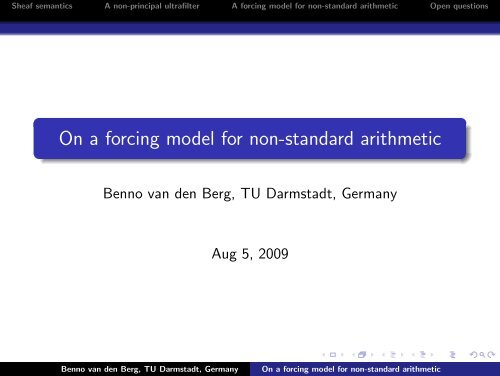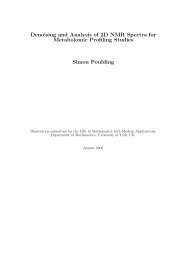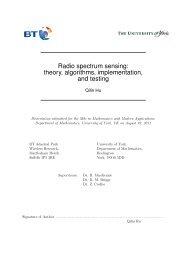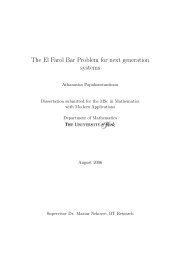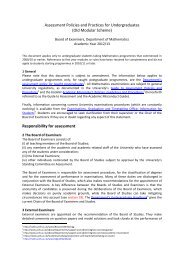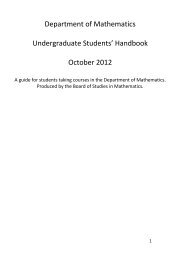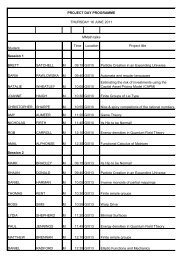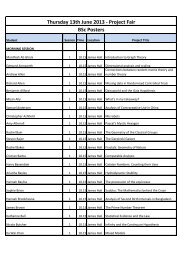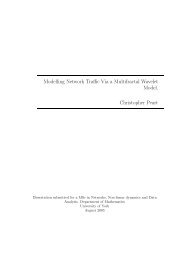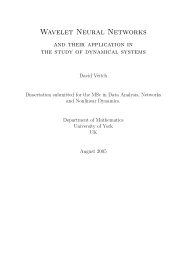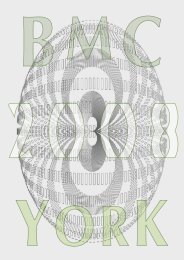On a forcing model for non-standard arithmetic
On a forcing model for non-standard arithmetic
On a forcing model for non-standard arithmetic
Create successful ePaper yourself
Turn your PDF publications into a flip-book with our unique Google optimized e-Paper software.
Sheaf semantics A <strong>non</strong>-principal ultrafilter A <strong><strong>for</strong>cing</strong> <strong>model</strong> <strong>for</strong> <strong>non</strong>-<strong>standard</strong> <strong>arithmetic</strong> Open questions<br />
<strong>On</strong> a <strong><strong>for</strong>cing</strong> <strong>model</strong> <strong>for</strong> <strong>non</strong>-<strong>standard</strong> <strong>arithmetic</strong><br />
Benno van den Berg, TU Darmstadt, Germany<br />
Aug 5, 2009<br />
Benno van den Berg, TU Darmstadt, Germany <strong>On</strong> a <strong><strong>for</strong>cing</strong> <strong>model</strong> <strong>for</strong> <strong>non</strong>-<strong>standard</strong> <strong>arithmetic</strong>
Sheaf semantics A <strong>non</strong>-principal ultrafilter A <strong><strong>for</strong>cing</strong> <strong>model</strong> <strong>for</strong> <strong>non</strong>-<strong>standard</strong> <strong>arithmetic</strong> Open questions<br />
Classical <strong><strong>for</strong>cing</strong><br />
Let P be a preorder.<br />
Then one has the following <strong><strong>for</strong>cing</strong> clauses:<br />
p −φ ∧ ψ ⇔ p −φ and p −ψ<br />
p −φ ∨ ψ ⇔ {q ≤ p : q −φ or q −ψ} is dense below p<br />
p −φ → ψ ⇔ <strong>for</strong> all q ≤ p, q −φ implies q −ψ<br />
p −∃xφ(x) ⇔ {q ≤ p : there exists an a such that q −φ(a)}<br />
is dense below p<br />
p −∀xφ(x) ⇔ <strong>for</strong> all q ≤ p and <strong>for</strong> all a, q −φ(a)<br />
Benno van den Berg, TU Darmstadt, Germany <strong>On</strong> a <strong><strong>for</strong>cing</strong> <strong>model</strong> <strong>for</strong> <strong>non</strong>-<strong>standard</strong> <strong>arithmetic</strong>
Sheaf semantics A <strong>non</strong>-principal ultrafilter A <strong><strong>for</strong>cing</strong> <strong>model</strong> <strong>for</strong> <strong>non</strong>-<strong>standard</strong> <strong>arithmetic</strong> Open questions<br />
Coverages<br />
This can be generalised using the notion of a coverage.<br />
A sieve on p is a downwards closed subset of ↓ p. A coverage Cov<br />
is a function that assigns to every p ∈ P a collection Cov(p) of<br />
sieves on p, in such a way that three axioms are satisfied:<br />
1 ↓ p ∈ Cov(p);<br />
2 if q ≤ p and S ∈ Cov(p), then S∩ ↓ q ∈ Cov(q);<br />
3 if S ∈ Cov(p) and Rq ∈ Cov(q) <strong>for</strong> every q ∈ S, then<br />
∪q∈SRq ∈ Cov(p).<br />
Example: the ¬¬-coverage.<br />
Cov(p) = {S ⊆↓ p : S is downwards closed and dense below p}.<br />
Benno van den Berg, TU Darmstadt, Germany <strong>On</strong> a <strong><strong>for</strong>cing</strong> <strong>model</strong> <strong>for</strong> <strong>non</strong>-<strong>standard</strong> <strong>arithmetic</strong>
Sheaf semantics A <strong>non</strong>-principal ultrafilter A <strong><strong>for</strong>cing</strong> <strong>model</strong> <strong>for</strong> <strong>non</strong>-<strong>standard</strong> <strong>arithmetic</strong> Open questions<br />
Covering semantics<br />
For a coverage Cov the <strong><strong>for</strong>cing</strong> clauses read as follows:<br />
p −φ ∧ ψ ⇔ p −φ and p −ψ<br />
p −φ ∨ ψ ⇔ {q ≤ p : q −φ or q −ψ} ∈ Cov(p)<br />
p −φ → ψ ⇔ <strong>for</strong> all q ≤ p, q −φ implies q −ψ<br />
p −∃xφ(x) ⇔ {q ≤ p : there exists an a such that q −φ(a)}<br />
∈ Cov(p)<br />
p −∀xφ(x) ⇔ <strong>for</strong> all q ≤ p and <strong>for</strong> all a, q −φ(a)<br />
Warning: For a general coverage it is no longer the case that<br />
classical logic is <strong>for</strong>ced! But the laws of intuitionistic logic are.<br />
Benno van den Berg, TU Darmstadt, Germany <strong>On</strong> a <strong><strong>for</strong>cing</strong> <strong>model</strong> <strong>for</strong> <strong>non</strong>-<strong>standard</strong> <strong>arithmetic</strong>
Sheaf semantics A <strong>non</strong>-principal ultrafilter A <strong><strong>for</strong>cing</strong> <strong>model</strong> <strong>for</strong> <strong>non</strong>-<strong>standard</strong> <strong>arithmetic</strong> Open questions<br />
Topos-theoretic perspective<br />
A presheaf on P is a functor P op → Sets.<br />
So it consists of a family of sets {X (p) : p ∈ P} together with a<br />
restriction operation assigning to every element x ∈ X (p) and<br />
q ≤ p an element x · q ∈ X (q).<br />
Presheaves <strong>for</strong>m a topos PSh(P). Every topos has an “internal<br />
logic”: the internal logic of categories of presheaves is Kripke<br />
semantics (<strong>for</strong> intuitionistic logic).<br />
Benno van den Berg, TU Darmstadt, Germany <strong>On</strong> a <strong><strong>for</strong>cing</strong> <strong>model</strong> <strong>for</strong> <strong>non</strong>-<strong>standard</strong> <strong>arithmetic</strong>
Sheaf semantics A <strong>non</strong>-principal ultrafilter A <strong><strong>for</strong>cing</strong> <strong>model</strong> <strong>for</strong> <strong>non</strong>-<strong>standard</strong> <strong>arithmetic</strong> Open questions<br />
Topos-theoretic perspective, continued<br />
A presheaf is a sheaf (relative to a coverage Cov) if it satisfies:<br />
Sheaf axiom<br />
For every S ∈ Cov(p) and family of elements {xq ∈ X (q) : q ∈ S}<br />
that is compatible (i.e. satisfies p ≤ q ∈ S ⇒ xq · p = xp), there is<br />
a unique element x ∈ X (p) such that x · q = xq <strong>for</strong> all q ∈ S.<br />
Sheaves also <strong>for</strong>m a topos Sh(P, Cov). The internal logic of<br />
categories of sheaves is precisely covering semantics. The internal<br />
logic of Sh(P, ¬¬) is classical <strong><strong>for</strong>cing</strong>.<br />
Benno van den Berg, TU Darmstadt, Germany <strong>On</strong> a <strong><strong>for</strong>cing</strong> <strong>model</strong> <strong>for</strong> <strong>non</strong>-<strong>standard</strong> <strong>arithmetic</strong>
Sheaf semantics A <strong>non</strong>-principal ultrafilter A <strong><strong>for</strong>cing</strong> <strong>model</strong> <strong>for</strong> <strong>non</strong>-<strong>standard</strong> <strong>arithmetic</strong> Open questions<br />
The work of Krivine<br />
In his (unpublished) paper<br />
Structures de réalisabilité, RAM et ultrafiltre sur N,<br />
Krivine constructs a <strong><strong>for</strong>cing</strong> <strong>model</strong> in which there exists an<br />
(explicit) <strong>non</strong>-principal ultrafilter on the natural numbers.<br />
How does this work?<br />
Benno van den Berg, TU Darmstadt, Germany <strong>On</strong> a <strong><strong>for</strong>cing</strong> <strong>model</strong> <strong>for</strong> <strong>non</strong>-<strong>standard</strong> <strong>arithmetic</strong>
Sheaf semantics A <strong>non</strong>-principal ultrafilter A <strong><strong>for</strong>cing</strong> <strong>model</strong> <strong>for</strong> <strong>non</strong>-<strong>standard</strong> <strong>arithmetic</strong> Open questions<br />
The <strong><strong>for</strong>cing</strong> <strong>model</strong><br />
Let P be the preorder consisting of infinite subsets of N, preordered<br />
by:<br />
p ≤ q ⇔ ∃n ∀k ≥ n (k ∈ p → k ∈ q),<br />
and let E = Sh(P, ¬¬). The object of truth values in E is<br />
Ω(p) = {closed sieves on p},<br />
where a sieve S is closed, if S dense below q implies q ∈ S. The<br />
power set PN = Ω N is given by<br />
Ω N (p) = {X : N → Ω(p)}.<br />
Benno van den Berg, TU Darmstadt, Germany <strong>On</strong> a <strong><strong>for</strong>cing</strong> <strong>model</strong> <strong>for</strong> <strong>non</strong>-<strong>standard</strong> <strong>arithmetic</strong>
Sheaf semantics A <strong>non</strong>-principal ultrafilter A <strong><strong>for</strong>cing</strong> <strong>model</strong> <strong>for</strong> <strong>non</strong>-<strong>standard</strong> <strong>arithmetic</strong> Open questions<br />
The ultrafilter<br />
So suppose X ∈ Ω N (p), i.e., X is a function N → Ω(p).<br />
The ultrafilter is given by: p −X ∈ U iff<br />
{q ≤ p : q ∈ X (n) <strong>for</strong> all n ∈ q} is dense below p.<br />
<strong>On</strong>e easily verifies that E believes this to be a filter, which does<br />
not contain the finite sets. So the main issue is to show that it is<br />
in fact an ultrafilter.<br />
Benno van den Berg, TU Darmstadt, Germany <strong>On</strong> a <strong><strong>for</strong>cing</strong> <strong>model</strong> <strong>for</strong> <strong>non</strong>-<strong>standard</strong> <strong>arithmetic</strong>
Sheaf semantics A <strong>non</strong>-principal ultrafilter A <strong><strong>for</strong>cing</strong> <strong>model</strong> <strong>for</strong> <strong>non</strong>-<strong>standard</strong> <strong>arithmetic</strong> Open questions<br />
Key combinatorial lemma<br />
The proof that U is an ultrafilter relies on the following lemma:<br />
Lemma<br />
Every infinitely descending sequence of elements<br />
x0 ≥ x1 ≥ x2 ≥ . . . in P has a lower bound.<br />
Proof.<br />
Suppose x0 ≥ x1 ≥ x2 ≥ . . . is an infinitely descending sequence in<br />
P. For every n the set <br />
i≤n xi is infinite, so one may construct a<br />
sequence of elements an ∈ <br />
i≤n xi with an = ai <strong>for</strong> all i < n. Then<br />
the set y = {a0, a1, a2, . . .} is a lower bound <strong>for</strong> the sequence.<br />
Nota bene: In a similar fashion one can show that P does not<br />
satisfy the countable chain condition!<br />
Benno van den Berg, TU Darmstadt, Germany <strong>On</strong> a <strong><strong>for</strong>cing</strong> <strong>model</strong> <strong>for</strong> <strong>non</strong>-<strong>standard</strong> <strong>arithmetic</strong>
Sheaf semantics A <strong>non</strong>-principal ultrafilter A <strong><strong>for</strong>cing</strong> <strong>model</strong> <strong>for</strong> <strong>non</strong>-<strong>standard</strong> <strong>arithmetic</strong> Open questions<br />
Model <strong>for</strong> <strong>non</strong>-<strong>standard</strong> <strong>arithmetic</strong><br />
We now try to compute the <strong>model</strong> of <strong>non</strong>-<strong>standard</strong> <strong>arithmetic</strong> this<br />
<strong>non</strong>-principal ultrafilter leads to.<br />
The natural numbers in E are what Bell calls “mixed natural<br />
numbers”: at level p, they consist of an anti-chains<br />
{qi ≤ p : i ∈ I } in P together with a natural number ni <strong>for</strong> each<br />
i ∈ I . (Where such anti-chains can be uncountable!)<br />
This makes the structure of N → N in E rather complicated.<br />
However using two lemmas we can keep things simple.<br />
Benno van den Berg, TU Darmstadt, Germany <strong>On</strong> a <strong><strong>for</strong>cing</strong> <strong>model</strong> <strong>for</strong> <strong>non</strong>-<strong>standard</strong> <strong>arithmetic</strong>
Sheaf semantics A <strong>non</strong>-principal ultrafilter A <strong><strong>for</strong>cing</strong> <strong>model</strong> <strong>for</strong> <strong>non</strong>-<strong>standard</strong> <strong>arithmetic</strong> Open questions<br />
First useful fact<br />
Lemma<br />
The ordinary functions N → N lie dense in the object playing the<br />
rôle of N → N in E, and there<strong>for</strong>e validity of statements<br />
concerning N → N in E can be reduced to validity of statements<br />
concerning ordinary functions N → N.<br />
Proof.<br />
Use the key combinatorial lemma.<br />
Benno van den Berg, TU Darmstadt, Germany <strong>On</strong> a <strong><strong>for</strong>cing</strong> <strong>model</strong> <strong>for</strong> <strong>non</strong>-<strong>standard</strong> <strong>arithmetic</strong>
Sheaf semantics A <strong>non</strong>-principal ultrafilter A <strong><strong>for</strong>cing</strong> <strong>model</strong> <strong>for</strong> <strong>non</strong>-<strong>standard</strong> <strong>arithmetic</strong> Open questions<br />
Second useful fact<br />
Lemma<br />
If S lies dense below p, then <strong>for</strong> all but finitely many n ∈ p there is<br />
a q ∈ S such that n ∈ q.<br />
Proof.<br />
Suppose not, et cetera.<br />
Benno van den Berg, TU Darmstadt, Germany <strong>On</strong> a <strong><strong>for</strong>cing</strong> <strong>model</strong> <strong>for</strong> <strong>non</strong>-<strong>standard</strong> <strong>arithmetic</strong>
Sheaf semantics A <strong>non</strong>-principal ultrafilter A <strong><strong>for</strong>cing</strong> <strong>model</strong> <strong>for</strong> <strong>non</strong>-<strong>standard</strong> <strong>arithmetic</strong> Open questions<br />
The <strong><strong>for</strong>cing</strong> clauses<br />
<strong>On</strong>e is led to the following <strong><strong>for</strong>cing</strong> clauses, where <strong>non</strong>-<strong>standard</strong><br />
natural numbers are interpreted as functions f : N → N:<br />
p −f = g ⇔ <strong>for</strong> all but finitely many n ∈ p, f (n) = g(n)<br />
p −f ≤ g ⇔ <strong>for</strong> all but finitely many n ∈ p, f (n) ≤ g(n)<br />
. . .<br />
Benno van den Berg, TU Darmstadt, Germany <strong>On</strong> a <strong><strong>for</strong>cing</strong> <strong>model</strong> <strong>for</strong> <strong>non</strong>-<strong>standard</strong> <strong>arithmetic</strong>
Sheaf semantics A <strong>non</strong>-principal ultrafilter A <strong><strong>for</strong>cing</strong> <strong>model</strong> <strong>for</strong> <strong>non</strong>-<strong>standard</strong> <strong>arithmetic</strong> Open questions<br />
Being <strong>standard</strong><br />
The <strong>model</strong> believes that a function f : N → N represents a<br />
<strong>standard</strong> natural number, if it is “locally constant”. More precisely:<br />
p −st(f ) ⇔ f ↾ p is bounded.<br />
In short, we end up with the <strong>model</strong> introduced by Avigad in:<br />
J. Avigad – Weak theories of <strong>non</strong><strong>standard</strong> <strong>arithmetic</strong> and analysis,<br />
in: Reverse mathematics 2001, Lect. Notes Log. 21, pp. 19–46.<br />
Benno van den Berg, TU Darmstadt, Germany <strong>On</strong> a <strong><strong>for</strong>cing</strong> <strong>model</strong> <strong>for</strong> <strong>non</strong>-<strong>standard</strong> <strong>arithmetic</strong>
Sheaf semantics A <strong>non</strong>-principal ultrafilter A <strong><strong>for</strong>cing</strong> <strong>model</strong> <strong>for</strong> <strong>non</strong>-<strong>standard</strong> <strong>arithmetic</strong> Open questions<br />
Intermediate intuitionistic <strong>model</strong>s<br />
Question: are there <strong>model</strong>s of intuitionistic <strong>non</strong>-<strong>standard</strong><br />
<strong>arithmetic</strong> such that what we saw above can be seen as the result<br />
of combining the intuitionistic <strong>model</strong> with a double negation<br />
translation?<br />
I believe this can be done in at least two ways.<br />
Benno van den Berg, TU Darmstadt, Germany <strong>On</strong> a <strong><strong>for</strong>cing</strong> <strong>model</strong> <strong>for</strong> <strong>non</strong>-<strong>standard</strong> <strong>arithmetic</strong>
Sheaf semantics A <strong>non</strong>-principal ultrafilter A <strong><strong>for</strong>cing</strong> <strong>model</strong> <strong>for</strong> <strong>non</strong>-<strong>standard</strong> <strong>arithmetic</strong> Open questions<br />
Intuitionistic <strong>model</strong> 1<br />
We work in PSh(P). This means: <strong><strong>for</strong>cing</strong> clauses <strong>for</strong> the atomic<br />
<strong>for</strong>mulas as above and the clauses <strong>for</strong> the interpretation of logical<br />
connectives as in Kripke semantics.<br />
Interesting fact:<br />
Lemma<br />
In PSh(P) the double negation shift holds:<br />
PSh(P) |= ∀n ∈ N(¬¬P(n)) → ¬¬∀nP(n).<br />
Proof.<br />
Use the key combinatorial lemma.<br />
Benno van den Berg, TU Darmstadt, Germany <strong>On</strong> a <strong><strong>for</strong>cing</strong> <strong>model</strong> <strong>for</strong> <strong>non</strong>-<strong>standard</strong> <strong>arithmetic</strong>
Sheaf semantics A <strong>non</strong>-principal ultrafilter A <strong><strong>for</strong>cing</strong> <strong>model</strong> <strong>for</strong> <strong>non</strong>-<strong>standard</strong> <strong>arithmetic</strong> Open questions<br />
Intuitionistic <strong>model</strong> 2<br />
Let B be the powerset of N, ordered by inclusion, and consider the<br />
ideal I of finite sets in N. I determines a coverage on B:<br />
S ∈ Cov(c) ⇔ ∃i ∈ I , b1, . . . , bn ∈ S : b1 ∨ . . . ∨ bn ∨ i = c,<br />
which we will also denote by I . In E = Sh(B, I ) the following<br />
defines an filter on N:<br />
p −X ∈ U ⇔ {q ≤ p : q ∈ X (n) <strong>for</strong> all n ∈ q} ∈ Cov(p).<br />
Forcing clauses <strong>for</strong> the atomic <strong>for</strong>mulas are as above and the<br />
clauses <strong>for</strong> the interpretation of logical connectives are as in<br />
covering semantics.<br />
Benno van den Berg, TU Darmstadt, Germany <strong>On</strong> a <strong><strong>for</strong>cing</strong> <strong>model</strong> <strong>for</strong> <strong>non</strong>-<strong>standard</strong> <strong>arithmetic</strong>
Sheaf semantics A <strong>non</strong>-principal ultrafilter A <strong><strong>for</strong>cing</strong> <strong>model</strong> <strong>for</strong> <strong>non</strong>-<strong>standard</strong> <strong>arithmetic</strong> Open questions<br />
Questions<br />
1 What holds in these intuitionistic <strong>model</strong>s? Which one is<br />
“better”?<br />
2 Jeremy Avigad and his student Henry Townser have used the<br />
classical <strong>model</strong> <strong>for</strong> proof-mining purposes. Is a direct<br />
functional interpretation of the language of <strong>non</strong>-<strong>standard</strong><br />
<strong>arithmetic</strong> possible?<br />
Benno van den Berg, TU Darmstadt, Germany <strong>On</strong> a <strong><strong>for</strong>cing</strong> <strong>model</strong> <strong>for</strong> <strong>non</strong>-<strong>standard</strong> <strong>arithmetic</strong>


